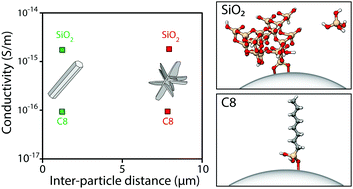The effect of ZnO particle lattice termination on the DC conductivity of LDPE nanocomposites†
Abstract
The effects of particle surface termination by zinc or oxygen were evaluated for composites containing micro-sized ZnO particles with rod shapes (17% oxygen terminations) or ball shapes (67% oxygen terminations), and it was found that the rods gave a conductivity (1.2 × 10−16 S m−1) half that given by the ball-shaped particles (2.4 × 10−16 S m−1). Both composites containing the micro-sized particles showed a conductivity almost two orders of magnitude lower than that of the LDPE reference material (1.2 × 10−14 S m−1). When a 5 nm thick silica coating was applied to the particles, the silica encapsulation eliminated the difference between the particles and resulted in both cases in an increase in conductivity by an order of magnitude to ca. 2 × 10−15 S m−1. The conductivity was still lower than that of the pristine polyethylene polymer. It was concluded that neither the particle morphology nor the inter-particle distance (1 μm for rods and 8 μm for balls) had any effect on the conductivity of the composites for identically terminated particles, while demonstrating that the conductivity of these materials relies uniquely on the particle surface terminations. In contrast, a markedly reduced conductivity was observed for composites containing the same particles but terminated with aliphatic hydrocarbon tails, the conductivity for both rod-shaped and ball-shaped particles (1 × 10−16 S m−1) being reduced to even lower values than for the pristine particles without surface modification. The same trend was observed with the 25 nm ZnO nanoparticles, showing a record low conductivity of 1 × 10−17 S m−1 for 3 wt% nanoparticles with aliphatic hydrocarbon tails. In practical applications, this would permit higher operation voltages than currently employed HVDC cable systems by controlling the resistivity of the composite insulation for various electric fields and temperatures and making it possible to tailor the dielectric design of cable components.

- This article is part of the themed collections: Materials Advances HOT Article Collection and International Open Access Week 2020


 Please wait while we load your content...
Please wait while we load your content...